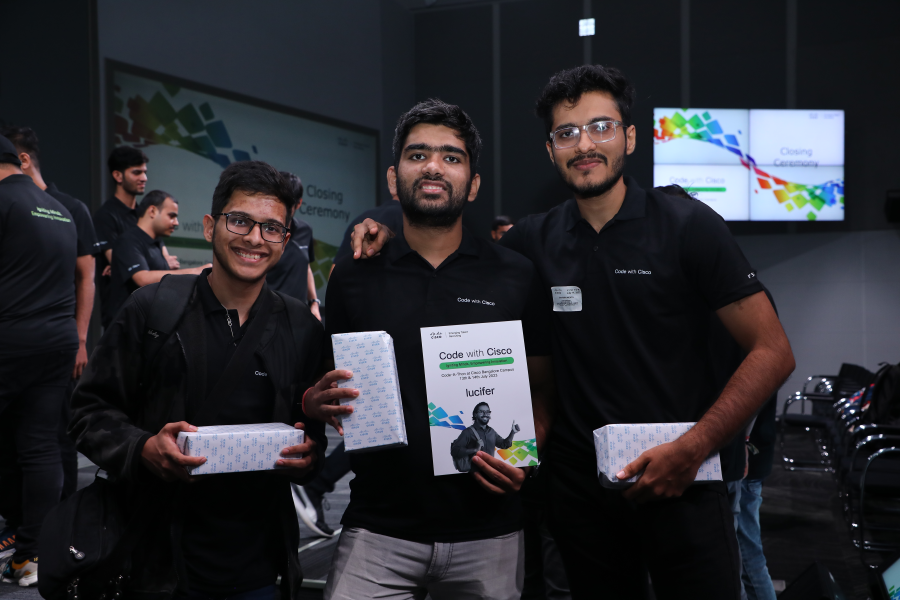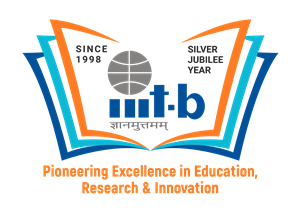
Hackathons are very intensive events that bring together individuals from diverse backgrounds, including programmers, designers and innovators, to collaboratively tackle complex challenges within a limited timeframe. Engaging in hackathons not only allows participants to showcase their technical skills and creativity but also fosters an environment of rapid learning and innovation. These dynamic settings encourage participants to think outside the box, experiment with new technologies and develop practical solutions to real-world problems.
Three students from 4th year iMTech batch from IIIT-Bangalore, Netradeepak Chinchwadkar, along with Satvik Verma and Dharmin Mehta participated and won in Code-a-thon ‘Code with Cisco’ that was held on July 13h and 14. Each of them received a GoPro Hero 11 camera that can shoot photos and videos in 5k, each being valued at 500 USD.
The 24-hour code-a-thon was designed to provide a dynamic platform for like-minded individuals to collaborate on a complex problem, exchange ideas and make an impact. There was an online assessment test to get into the hackathon to which an approximately 20000 teams registered and 14000 teams were qualified to give the exam, finally only 24 were selected!
“Being selected in online DSA round itself was a monumental task and we were ecstatic when we saw the result, for we were selected. In an upcoming mail we received the theme of the hackathon, “If it’s connected, it’s protected (Security and Networking)”. So we prepared and researched a possible solution accordingly. We left campus on 12th July to go to the stay arranged by Cisco. The specifics of the hackathon’s problem statements weren’t explicitly mentioned yet, so we proceeded to code our application which we though would be apt for the overarching theme,” says Netradeepak.
But just getting an entry into the hackathon didn’t add to the excitement. On the 13th, the students reached Cisco office at Bangalore, where we were directed to the designated room for the upcoming hackathon. The moment we set foot in that room, an exhilarating surge of adrenaline coursed through us, as we were acutely aware that the journey ahead was poised to be anything but simple. The team was up against the top 24 teams from across the country.

After an introduction speech by the welcoming and encouraging team of Cisco, they were given our problem statements. There were three tracks in the hackathon, one of them being “Fry the Phish”, in which the team was required to make a simulation of attackers and defenders inside of a network. “This is the track that we received. In addition, unlike most hackathons that we had participated prior to this one which spanned across days giving us plenty of time to research, we had but 10 hours here. To be brutally honest, we were woefully underprepared. We had worked the previous night as well as a few earlier ones working on a secure document storage application, which mind you the team is still working on outside of the hackathon as we truly believed it was a great idea, but nonetheless, an interactive simulation was the last thing we would have guessed we would need to make. We could have panicked and given up there and then for that was the easy route, but the key to persisting was staying calm and counting our resources,” adds Satvik.
Having prior experience in crafting physics simulations and an extensive self-driven exploration of the gaming industry, Deepak shared his valuable industry insights with the team. Together, they conceptualized an initial spark—an idea rooted in inspiration. This inspiration harked back to a beloved game from their childhoods, “Plants vs. Zombies.”
Outlining the subsequent stages, Dharmin says, “We made a target demo graph, decided that our application intends to educate younger audiences, and crafted out hypothetical monetization model and game-loop around it. We aimed for a product that would have been a perfect match but, as we would soon find out, prove to be overly ambitious. One important thing that we did was decide which part of our application we can keep and which part we need to discard for first prototype as it had to be a Minimum Viable Product. Luckily we picked our fights intelligently and were able to create the needful.”
The next day the team created their presentation which they framed as a business pitch. we showcased not only the application’s usage but also its target audience and the ways it could generate profits while outshining competitors. The outcomes swiftly materialized, and to their astonishment, victory was theirs and the success was beyond belief.

The students recall the support and guidance our Director, Prof. Debabrata Das who played a pivotal role in equipping them. Prior to the hackathon, his guidance primed them with a comprehensive approach to tackle a task as monumental as this. Code-a-thon “Code with Cisco” provided a dynamic platform for like-minded individuals to collaborate on a complex problem, exchange ideas and make an impact. Beyond the competitive aspect, it promoted a great teamwork, networking and the exchange of ideas, sums up, Netradeepak.


